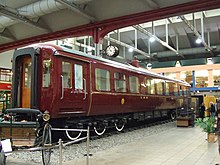British Royal Train
The earliest royal coaches date back to the mid-19th century in the reign of Queen Victoria; until an upgrade in 1977 there were multiple sets based in different regions, a legacy of the pre-nationalisation era of railways in Britain.
[2] In November 2020, the American PBS network aired a two-part series, Secrets of Royal Travel, with the first episode featuring the train and its history.
[7] The train transported the queen from Slough to London Paddington, and was hauled by the locomotive Phlegethon, driven by Daniel Gooch assisted by Isambard Kingdom Brunel.
In the matters of the decorations and furniture of the saloons the Company consulted their Royal Highnesses, whose choice rested on quiet, and at the same time artistic, ornamentation.
The inlaid panels and Lincrusta-Walton dados, in which the rose, shamrock, and thistle are designed, show great taste of skilled workmanship, and the same remark may be applied to the furniture in the saloon, which consists of sofas and easy-chairs upholstered in dark green morocco, that being the colour and material which her Royal Highness preferred to any other.
[13]Nearly sixty years later, after her funeral in 1901, Queen Victoria's coffin was taken to London Paddington and transported on the royal train back to Windsor, where she is buried.
The King's saloon had a smoking room in mahogany, with inlays of rosewood and satinwood, and a day compartment in the Colonial style, in white enamel.
Edward VII used this for the first time on 7 September 1908 for a journey to Ollerton railway station when visiting Rufford Abbey to stay with Lord and Lady Savile for the Doncaster Races.
[16] In 1912, the Midland Railway provided a royal saloon for George V. It was built at the company workshops in Derby under the supervision of D. Bain, the works superintendent, and fitted out by Waring & Gillow.
This was constructed in their own workshops and used for the first time during a visit by the Duke and Duchess of York in September 1897 and a trip from Banagher to Clara over the tracks of the Great Southern and Western Railway.
In 1941, the LMS built three armour-plated saloons with safe cabinets for documents, for George VI, who travelled to parts of England that were under bombing raids during World War II.
A 2020 report stated that they included a lounge for the Queen, another for Prince Philip, as well as carriages that serve as bedrooms, bathrooms, a dining car and a couchette.
[30] Train drivers are specially selected based on their skills, including the ability to make a station stop within six inches of the designated position.
[31][32] In November 1883, at the time of the Fenian dynamite outrages in England, the government received anonymous information that an attempt would be made against Queen Victoria's forthcoming journey from Windsor to Ballater.
The report could not be corroborated, and could have been a mischievous hoax, but the Home Secretary, William Harcourt, asked George Findlay, general manager of the LNWR, to arrange special protection.
Jointly with the other companies along the route, platelayers and other workers were mobilised to inspect every bridge along the 600-mile (970 km) journey and to watch over the line, each watcher in sight of the next, until the train had passed.
However, Gerald Fiennes wrote in his autobiography I Tried to Run a Railway of one incident on the Eastern Region when an ex-LNER A4 class 4-6-2 was used to pull the Royal Train.
[35] In June 2000, a member of the Royalty Protection Branch (SO14) accidentally discharged his 9mm Glock automatic pistol while the train was halted for an overnight stop in South Wales.
[41] On 11 June 2002, the restored 6233 Duchess of Sutherland was the first steam locomotive to haul the Royal Train for 35 years,[42] transporting Queen Elizabeth II on a tour to North Wales, from Holyhead to Llandudno Junction, as part of her Golden Jubilee.
[43] On 22 March 2005, Duchess of Sutherland again hauled the Royal Train, the second time for a steam locomotive in 40 years, transporting the Prince of Wales from Settle to Carlisle over the Settle-Carlisle line.
[45] On 10 June 2008, 6024 King Edward I hauled the Royal Train, transporting the Prince of Wales and the Duchess of Cornwall on board, from Kidderminster Town to Bridgnorth, on a visit to the Severn Valley Railway.
[41] On 4 February 2010, Tornado again hauled the Royal Train, taking the Prince of Wales and the Duchess of Cornwall to the Museum of Science and Industry in Manchester.
[48] On 24 January 2012, BR 70000 Britannia hauled the royal train, taking the Prince of Wales from Preston to Wakefield for a renaming ceremony to commemorate 70000's recent return to traffic after an overhaul.
[49] This was also one of the locomotives considered for use during the Queen's tour of North Wales in 2002, although 6233 Duchess of Sutherland was eventually chosen for the trip from Newport to Hereford, and then from Worcester to Oxford.
The new formation has a higher maximum speed, depending on the locomotive, an important factor if slots are to be found for the train on crowded main lines.
Following the wedding of Prince Charles and Lady Diana Spencer on 29 July 1981, the honeymoon royal train configuration was formed with inspection saloon 975025 Caroline.
[61] Edward Leigh, the Conservative chairman of the House of Commons Public Accounts Committee, said the Royal Train was twice as expensive as using air travel but hardly luxurious.
[citation needed] In December 2020, the Duke and Duchess of Cambridge embarked on a three-day tour of England, Scotland, and Wales via the British Royal Train "to pay tribute to the inspiring work of individuals, organisations and initiatives across the country that have gone above and beyond to support their local communities" throughout the year.









